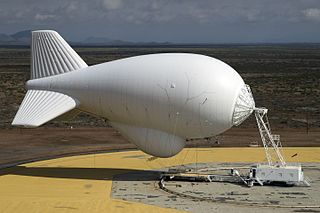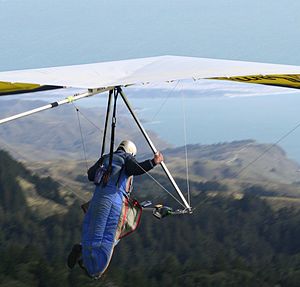
An aircraft is a vehicle that is able to fly by gaining support from the air. It counters the force of gravity by using either static lift or the dynamic lift of an airfoil, or, in a few cases, direct downward thrust from its engines. Common examples of aircraft include airplanes, helicopters, airships, gliders, paramotors, and hot air balloons.

Aeronautics is the science or art involved with the study, design, and manufacturing of air flight-capable machines, and the techniques of operating aircraft and rockets within the atmosphere. While the term originally referred solely to operating the aircraft, it has since been expanded to include technology, business, and other aspects related to aircraft. The term "aviation" is sometimes used interchangeably with aeronautics, although "aeronautics" includes lighter-than-air craft such as airships, and includes ballistic vehicles while "aviation" technically does not.

Hang gliding is an air sport or recreational activity in which a pilot flies a light, non-motorised, fixed-wing heavier-than-air aircraft called a hang glider. Most modern hang gliders are made of an aluminium alloy or composite frame covered with synthetic sailcloth to form a wing. Typically the pilot is in a harness suspended from the airframe, and controls the aircraft by shifting body weight in opposition to a control frame.

A fixed-wing aircraft is a heavier-than-air aircraft, such as an airplane, which is capable of flight using aerodynamic lift. Fixed-wing aircraft are distinct from rotary-wing aircraft, and ornithopters. The wings of a fixed-wing aircraft are not necessarily rigid; kites, hang gliders, variable-sweep wing aircraft, and airplanes that use wing morphing are all classified as fixed wing.

Paragliding is the recreational and competitive adventure sport of flying paragliders: lightweight, free-flying, foot-launched glider aircraft with no rigid primary structure. The pilot sits in a harness or in a cocoon-like 'pod' suspended below a fabric wing. Wing shape is maintained by the suspension lines, the pressure of air entering vents in the front of the wing, and the aerodynamic forces of the air flowing over the outside.

Flight or flying is the process by which an object moves through a space without contacting any planetary surface, either within an atmosphere or through the vacuum of outer space. This can be achieved by generating aerodynamic lift associated with gliding or propulsive thrust, aerostatically using buoyancy, or by ballistic movement.
Kite types, kite mooring, and kite applications result in a variety of kite control systems. Contemporary manufacturers, kite athletes, kite pilots, scientists, and engineers are expanding the possibilities.

Ridge lift is created when a wind strikes an obstacle, usually a mountain ridge or cliff, that is large and steep enough to deflect the wind upward.

An aerostat or lighter-than-air aircraft is an aircraft that relies on buoyancy to maintain flight. Aerostats include the unpowered balloons and the powered airships.

Early flying machines include all forms of aircraft studied or constructed before the development of the modern aeroplane by 1910. The story of modern flight begins more than a century before the first successful manned aeroplane, and the earliest aircraft thousands of years before.

Hang gliding is an air sport employing a foot-launchable aircraft. Typically, a modern hang glider is constructed of an aluminium alloy or composite-framed fabric wing. The pilot is ensconced in a harness suspended from the airframe, and exercises control by shifting body weight in opposition to a control frame.

The NASA Paresev was an experimental NASA glider aircraft based upon the kite-parachute studies by NASA engineer Francis Rogallo.
Airborne wind energy (AWE) is the direct use or generation of wind energy by the use of aerodynamic or aerostatic lift devices. AWE technology is able to harvest high altitude winds, in contrast to wind turbines, which use a rotor mounted on a tower.
Gliding flight is heavier-than-air flight without the use of thrust; the term volplaning also refers to this mode of flight in animals. It is employed by gliding animals and by aircraft such as gliders. This mode of flight involves flying a significant distance horizontally compared to its descent and therefore can be distinguished from a mostly straight downward descent like a round parachute.

A glider is a fixed-wing aircraft that is supported in flight by the dynamic reaction of the air against its lifting surfaces, and whose free flight does not depend on an engine. Most gliders do not have an engine, although motor-gliders have small engines for extending their flight when necessary by sustaining the altitude with some being powerful enough to take off by self-launch.

Kites are tethered flying objects which fly by using aerodynamic lift, requiring wind for generation of airflow over the lifting surfaces.
Kite mooring refers to a specific method used to secure a kite in flight. The two fundamental parts of a kite are the wing and the kite line. The kite must be moored to a mobile or fixed object to develop tension in the kite line which converts to lift and drag, enabling the kite to fly.

Gliding is a recreational activity and competitive air sport in which pilots fly unpowered aircraft known as gliders or sailplanes using naturally occurring currents of rising air in the atmosphere to remain airborne. The word soaring is also used for the sport.

A glider or sailplane is a type of glider aircraft used in the leisure activity and sport of gliding. This unpowered aircraft can use naturally occurring currents of rising air in the atmosphere to gain altitude. Sailplanes are aerodynamically streamlined and so can fly a significant distance forward for a small decrease in altitude.
Unpowered flight is the ability to stay airborne for a period of time without using any power source. There are several types of unpowered flight. Some have been exploited by nature, others by humankind, and some by both.















